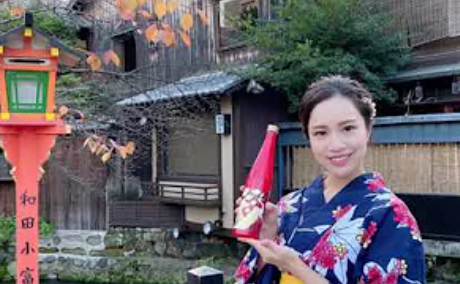The enduring appeal of kaku-uchi is straightforward, said Yoshida: they’re cheap and people feel at ease whether they want to socialise or drink alone. Fellow Kaku-uchi Culture Study Group members Kiyomi Ono, Tomoko Ikemoto and Yuki Yoshioka – all women – agreed. And while kaku-uchi are traditionally the remit of men, women are increasingly blending in.
“Twenty years ago, my male colleagues refused to take me, saying that kaku-uchi were for men only,” said office worker and Kitakyushu resident Ikemoto. Decades on, she’s finally satisfied her curiosity by recently joining the kaku-uchi group. Yoshioka joined because she feels more comfortable drinking in a group than on her own.
Many kaku-uchi are also aiming to attract a young clientele. Akiyasu Seki is the owner of Tokyo kaku-uchi Futaba and president of the Tokyo Liquor Retailers Association’s youth branch. The organisation, which unites 2,300 liquor shops, promotes sake culture and responsible drinking among young people; and in 2018 it launched the Liquor Store Kaku-uchi Festival, with one of its latest editions attracting 30,000 participants. Held in Tokyo twice a year, dozens of the city’s liquor shops have stalls for people to taste their products while enjoying food and live music.
Seki explained that kaku-uchi used to be popular in Tokyo but practically disappeared in the late 1990s and early 2000s when hygiene regulations were tightened, obliging liquor shops to register as restaurants to serve food and drinks. Now, however, they’re experiencing a revival. “Historically, liquor shops are places where people exchange information about the neighbourhood and, in Tokyo, kaku-uchi are increasingly becoming part of the fabric of the community,” he said.
Yet Seki pointed out that, while the capital’s kaku-uchi are increasing, its liquor shops are declining and, in fact, “more of them have started kaku-uchi businesses as a way to survive”.
In Kitakyushu, liquor shops – and hence kaku-uchi – are suffering too. Uozumi, founded by the Uozumi family in 1934, is tucked away among scruffy-looking residential buildings in the Moji district, less than 2km from Sake no Awaya. The wooden interior is a narrow rectangular space mostly occupied by a counter, where customers stand facing shelves full of bottles, ornaments and old photographs. The remaining wall space is pasted with beer posters whose faded, tattered appearance and retro-looking models reveal just how long they’ve been there.
The owner, Tetsuji Uozumi, a soft-spoken man with a warm smile, showed me and the Kaku-uchi Culture Study Group outing I’d joined a photo of his mother. She used to run the business, but after she passed away, Uozumi was left on his own. “I can just about support myself, but no one will take over after me,” he said.
Like Uozumi, almost 80% of Kitakyushu’s liquor shops don’t have successors, according to a 2015 study by Yuki Nakashima and Bart Dewancker of the University of Kitakyushu’s Architecture Department. While the number of liquor shops kept growing until the 1970s, since then, the downward trend has been relentless, due to proprietors ageing and not being able to pass on their businesses, as well as competition from other types of retailers selling alcohol, such as supermarkets and convenience stores. Yoshida estimated that 80 years ago there were double the kaku-uchi there are now.
After leaving Uozumi and saying goodbye to Yoshida and the other group members, I met Stephen Lyman, co-author of the book The Complete Guide to Japanese Drinks, in Fukuoka, a 15-minute bullet train ride from Kitakyushu. Fukuoka is another kaku-uchi hotspot, and Lyman and I chatted about his favourite joints, such as Koba Saketen, a shop specialising in sake and wine that he praised for its friendly atmosphere and good drink selection.
Lyman also recommended Todoroki Saketen Yakuin Stand, which sells hundreds of varieties of sake as well as natural wine and craft beer, noting that this is a good spot for foreigners visiting a kaku-uchi for the first time as it’s particularly accepting of newcomers.
Lyman, who’s American, pointed out that many other kaku-uchi are small, local businesses mainly catering to regulars. So for those who wish to explore this scene (regardless of the venue they choose), some things should be kept in mind. For example, knowing even a little basic Japanese can go a long way. Also, many kaku-uchi only take cash, only accept small groups and don’t have toilets.
Lyman remains convinced, however, that kaku-uchi are a unique way of exploring Japanese drinking culture and neighbourhood life, and are, overall, welcoming places. He recalled that Koba was the first kaku-uchi he ever visited and that, at the time, he was pleasantly surprised to see drinks being served in the shop. Holding a pint of Japanese craft cider, Lyman exclaimed: “Of course you should be able to raise a glass to new and old friends inside a liquor store!”
